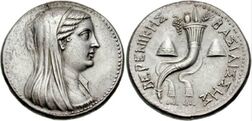Imperial stater
| Imperial stater | |
| Imperial Stater | |
 $20 coin struck during the reign of Olympia, using her temple name of Berenice. | |
| MOS–4 | |
|---|---|
| Code | COS |
| Denominations | |
| Subunit | |
| 1/100 | Drachma (only for accounting purposes) |
| Banknotes | |
| Freq. used | $ 20, $ 50, $ 100 |
| Rarely used | $ 500, $ 1000 |
| Coins | |
| Freq. used | $ 1, $ 5, $ 10, |
| Rarely used | $ 20 |
| Demographics | |
| Issuance | |
| Central bank | Basileusan Bank |
The Imperial Stater (CON $) is the official currency of the Imperial State of Constancia.
History
The Imperial Stater was a fresh issuance of fiat currency, backed by the strength and prestige of the Constancian State and economy after the disastrous effects of the Euran War and its related difficulties, such as the complete destruction of Vey. Effective 1 Phoinikaios 1654 (1.XV.1654), the Stater was declared the official currency and legal tender for all public and private debts in Constancia.
As of 1653, the exchange rate of the Imperial Stater was:
3 Constancian Staters = 1 Imperial Erb of Shireroth
1 Constancian Stater = 0.33 Imperial Erb of Shireroth:
4 Constancian Stater = 1 Natopian Natopo
1 Constancian Stater = 0.25 Natopian Natopo
This valuation was deemed too optimistic, as evidenced by the appearance of a rival currency black market, with more realistic exchange rates, in Aqaba. With the establishment of the Imperial State by the promulgation of the Magna Carta of 1667, the Stater was renamed into the Imperial Stater.
At 25.VII.1670, the exchange rate of the Imperial Stater was fixed as follows:
1 Imperial Stater = 0.0016 Shirerithian Erb
1 Shirerithian Erb = 642.56 Imperial Stater
1 Imperial Stater = 0.00020 Natopian Natopo
1 Natopian Natopo = 4,911.04 Imperial Stater
1 Imperial Stater = 0.000018 Craitish Cräite
1 Craitish Cräite = 55,687.65 Imperial Stater
The Imperial Stater valuation via currency board was soon abandoned in favor of a floating, market-determined rate, with the Basileusan Bank engaging in open market operations as the need arose. Negotiations with Raspur Pact economic partners soon resulted in the Basileusan Bank ensuring a significant reserve in former Kalgarrands, now Benacian Sovereigns, the Alduro-Wechua écu, the Craitish Cräite, and the Natopo.
As of 1690, the Imperial Stater averages valuation of 0.02 Natopos, or 1 Natopo resulting to around 50 Imperial Staters, but opened on the first day of 1691 at 48.91 Imperial Staters to the Natopo.
The continued strengthening of the Constancian economy resulted in an improved valuation of the Imperial Stater in 1700, as well as its use as a reserve currency, with the Imperial Stater averaging valuation of 1 Natopo resulting to around 20 Imperial Staters, and 1 New Alexandrian écu (€) resulting to around 10 Imperial Staters.
The 1725 Constancian crisis resulted in the Imperial Stater falling to a valuation of 1 Natopo resulting to 15 Imperial Staters from a usual valuation of 1 Natopo to 12 Imperial Staters. As a result of this, and the current cost-of-living crisis, there has also been much discussion as to whether there is a need to introduce a $ 5000 or $ 10,000 note. If so introduced, public polling favors the visage of the Basilinna Olympia.
Administration
The Imperial Stater is managed and administered, and fully guaranteed by the Basileusan Bank.
Excluding commemorative notes and coins, there are about 3.9 billion pieces of notes valued at $ 1.3 trillion and 31.8 billion pieces of coins valued at $ 39.5 billion in circulation as of 1.I.1687.
Characteristics
Currency sign
The currency sign that represents the Imperial Stater is $.
Banknotes
Free and Associative Kingdom of Constancia
Banknotes issued during this period were sized 16 centimeters x 6.6 centimeters, always had a stylized portrait of Petros III at the obverse, and a stylized portrait of Cleo in the reverse. The obverse was primarily in black ink with some items emphasized in gold, with the reverse always in green.
Imperial State of Constancia
1667 Series
Banknotes issued during this period were sized 16 centimeters x 6.6 centimeters, always had a stylized portrait of Petros III at the obverse, and a stylized portrait of Cleo in the reverse. The obverse was primarily in black ink with some items emphasized in gold, with the reverse always in Imperial Constancian purple.
1688 Series
Banknotes issued during this period were sized 16 centimeters x 6.6 centimeters, always had a stylized portrait of Basilinna Olympia at the obverse, and a stylized portrait of Autokrator of Constancia Jaime Augusto Joaquin Primo de Aguilar in the reverse. The obverse was primarily in black ink with some items emphasized in gold, with the reverse always in Imperial Constancian purple.
1704 Series
Banknotes issued during this period were sized 18.9 cm × 8.0 cm, always had a stylized portrait of Basileus Giakoumis at the obverse, and a stylized portrait of Basileusa Esmeralda al-Osman in the reverse. The obverse was primarily in black ink with some items emphasized in gold, with the reverse always in Imperial Constancian purple.
1743 Series
Banknotes issued during this period were sized 18.9 cm × 8.0 cm, always had a stylized portrait of Basileus Giakoumis II at the obverse, and a stylized portrait of Princess Rosamund, Autokrator of Constancia, in the reverse. The obverse was primarily in black ink with some items emphasized in gold, with the reverse always in Imperial Constancian purple.